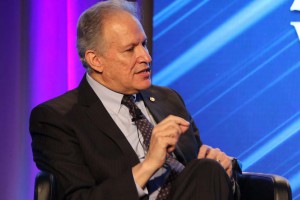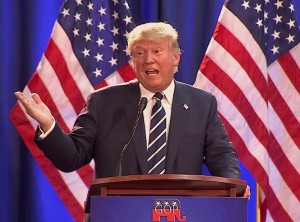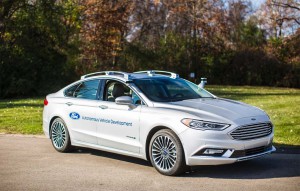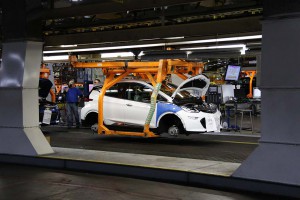Barring an unexpected, December surprise, 2016 will go out like a lion for the U.S. auto industry, automakers collectively racking up their third consecutive year of record sales. That’s an all the more massive achievement considering the decade began with the worst downturn the U.S. car market had suffered since the Great Depression.
What’s ahead for the industry is far from certain, demand showing signs of losing momentum in recent months. But what’s clear is that 2016 will not only go down in the record book from a sales perspective but that the year could be seen as marking a series of major transitions – “an inflection point,” in the words of John Krafcik, the CEO of Waymo, Google’s recently renamed autonomous vehicle subsidiary.
What was once the stuff of science fiction began shifting into everyday reality this past year, with hundreds of self-driving vehicle prototypes taking to public roads across the country – some even being used as part of ride-sharing pilot programs in Pittsburgh and San Francisco.
(US car sales end ’16 with likely record. But what about 2017? Click Here for more.)
Several automakers, including Tesla, said they hope to have their first fully self-driving cars on sale before 2020, with most other major auto manufacturers targeting some point early in the coming decade. Ford went so far as to promise it would begin building completely driverless cars in 2021.
The National Highway Traffic Safety Administration not only released the first federal guidelines for autonomous vehicles but also announced preliminary rules that will soon have cars “talking” to one another, sharing their location, speed and direction.
“It has been estimated that up to 80% of non-impaired collisions could be avoided or mitigated to reduce injuries” with the widespread use of so-called vehicle-to-vehicle, or V2Vm technology, said U.S. Transportation Secretary Anthony Foxx, who also said the Department of Transportation will now consider the possibility of requiring V2V systems on commercial trucks, as well.
Vehicle safety was one of the year’s big stories, especially in the wake of a series of industry lapses that saw more than 100 deaths linked to faulty General Motors ignition switches, and at least 15 deaths worldwide due to defective Takata airbags. In fact, NHTSA last spring ordered the recall of more than 60 million vehicles using those airbags – the largest safety-related service action in U.S. history.
(Takata facing multi-billion criminal penalty. Click Here for the latest.)
Automotive recalls have been running at their own record pace for several years. Thanks to the Takata problem, the industry could set another overall record for 2016.
On the positive side, the year began with two dozen automakers entering into an unprecedented consortium with NHTSA aimed at developing next-generation safety systems – such as forward collision warning with automatic emergency braking. According to NHTSA Administrator Mark Rosekind, that could bring advanced systems to market “years ahead” of what would be possible using the traditional rule-making process.

Outgoing NHTSA Administrator Mark Rosekind pressed makers for improved safety - but also ushered in a new era of cooperation.
Members of the consortium, such as Nissan CEO Carlos Ghosn, have said they now believe it is possible to reach a point where there would be zero highway deaths in the U.S. – a major breakthrough considering fatalities were up 8% in 2015, to more than 33,000, and may have jumped as much as 10% this year.
The outgoing year may also be seen as the point when zero-emission vehicles began the transition from niche to mainstream. Combined sales of hybrids, plug-ins and pure battery-electric vehicles have accounted for barely 3% of U.S. new vehicle sales. But experts believe that will start to rise sharply due to several factors:
- First, there was the December decision by the Environmental Protection Agency to stick with planned rules calling for new vehicles to deliver an average 54.5 mpg in 2025;
- Then there was the launch of the Chevrolet Bolt EV, the first long-range electric vehicle priced for the mainstream – under $30,000 after federal tax credits.
Dozens of automakers, from mainstream marques Ford, Toyota and Volkswagen to upscale brands BMW, Mercedes-Benz and even Aston Martin, announced their own long-range EV plans this past year. Consulting firm IHS Automotive predicted sales of pure EVs could top 3 million by 2025, and some industry planners believe the figure could run twice as high.
In some parts of the world, regulators have begun envisioning a time when the internal combustion engine could vanish entirely. That’s not likely to happen anytime soon in the U.S. But the outgoing year saw new questions raised about the future of the diesel. Nicknamed the “oil burner,” it had been gaining momentum for much of the decade. Then came the EPA revelation in September 2015 that VW had cheated on emissions tests.
The automaker agreed to a record, $14.7 billion settlement with federal and California regulators in June, and a second deal was announced in mid-December worth $2 billion. Ultimately, VW could wind up buying back more than 500,000 diesel vehicles. And it now says it will stop selling diesels in the U.S., focusing instead on electric power. That could lead other manufacturers to shift strategy.
Other key automotive trends and stories from 2016 included:
- The rapid expansion of ride- and car-sharing services such as Uber, Lyft and Car2Go. Some forecasters believe that millions of Americans will abandon the family car over the next decade, especially if ride-sharing services can launch driverless vehicles, sharply driving down their costs;
- The infotainment revolution. For many car buyers, having a touchscreen display, Apple CarPlay and Bluetooth audio has become more important than horsepower and automotive design.

No one is certain what President-elect Donald Trump will do about CAFE rules and other auto regulations once inaugurated.
(China slams GM with fine some see as warning shot for Trump. Click Here for the story.)
The year’s other big story will really not begin to play out until next year, but president-elect Donald Trump has already promised to slash government bureaucracy and cut existing regulations. The auto industry would clearly like to see him roll back those 2025 fuel economy standards. But they’re also worried about possible new tariffs that could restrict imports of foreign-made autos and auto parts.
And the next president will face the prospect of launching his term in the White House just as the auto industry seems poised to enter another cyclic downturn. For a candidate who promised to deliver jobs and return manufacturing to American soil, an automotive sales slide could mark a bad start for his administration.
(This story first appeared on NBCNews.com.)



